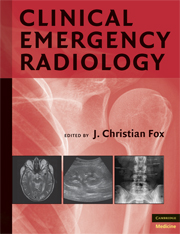Book contents
38 - The Physics of MRI
from PART IV - MAGNETIC RESONANCE IMAGING
Published online by Cambridge University Press: 07 December 2009
Summary
Although CT continues to be the diagnostic imaging modality of choice for many clinical situations facing the emergency physician, MRI is quickly becoming the preferred alternative for evaluating certain complaints. Not only does MRI spare the patient from exposure to the ionizing radiation of CT, but it also has a well-deserved reputation of producing superior images of soft tissue structures, such as tumors, abscesses, the brain, and the spinal cord. This chapter elucidates how these amazing images are derived, in the simplest of terms and without any of the anxiety-inducing equations for which physics is famous.
ESSENTIAL PHYSICAL PRINCIPLES
Before one can understand the physics of MRI, it is important to review some of the essential physical principles that make MRI possible. Recall from your high school physics class that the hydrogen atom consists of a proton nucleus, which carries a unit of positive electrical charge, and a single electron, which carries a negative charge equal in magnitude to that of the proton. These hydrogen atoms are the simplest and most abundant elements in the human body, serving as the basic building blocks of everything from water molecules to lipids to proteins. The atomic nuclei of these hydrogen atoms, in addition to many others, act as small magnets due to the small magnetic dipole moments that they carry.
Keywords
- Type
- Chapter
- Information
- Clinical Emergency Radiology , pp. 517 - 520Publisher: Cambridge University PressPrint publication year: 2008

